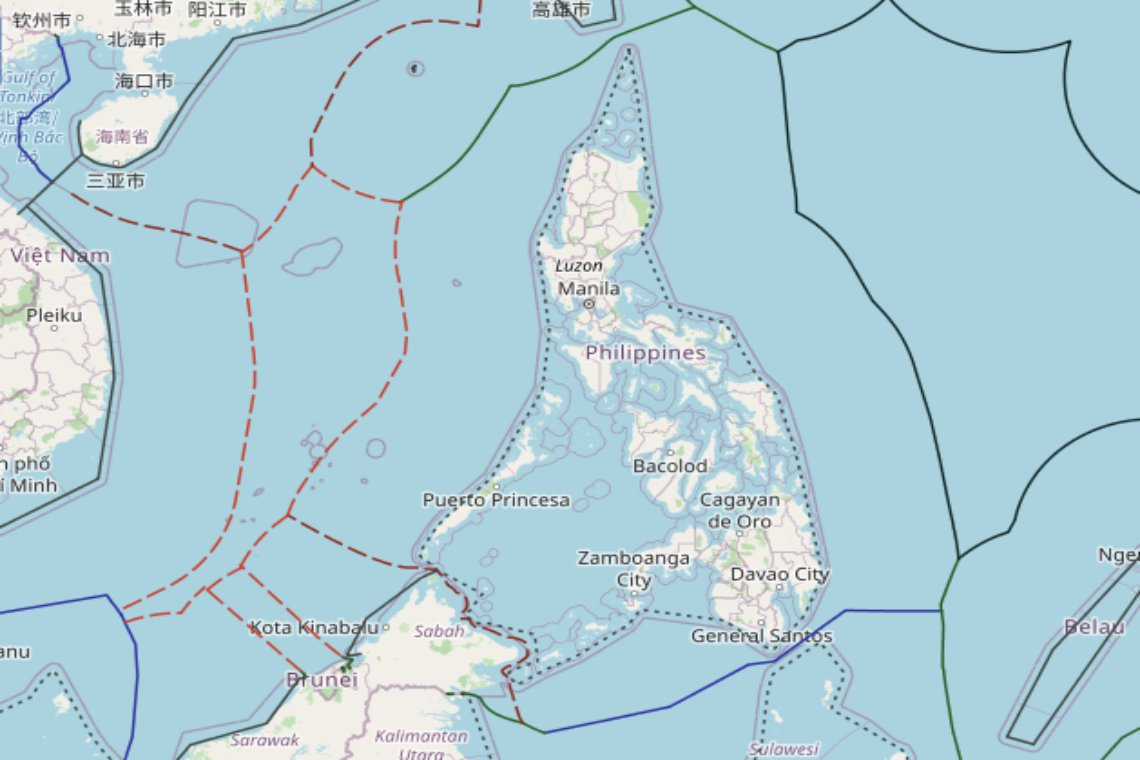The Philippine Claim. Image Source: https://iilss.net/tag/philippines-continental-shelf-map/
In recent years, Southeast Asia has experienced rising instability fueled by nationalist territorial ambitions, straining diplomatic relationships and regional harmony.
One clear example is the Philippines’ recent attempt to extend its continental shelf by 200 miles into the West Sulu Sea—a claim rejected by international authorities due to insufficient geological evidence. This unsuccessful bid highlights a broader geopolitical trend, mirrored in China's assertive claims in the South China Sea and the Sultanate of Sulu’s continued attempts to assert territorial rights over Sabah without sufficient evidence.
The Philippines' Maritime Ambitions
The Philippines’ 2021 continental shelf bid (and continued into 2024 with a UN claim) emerged from economic interests, national pride, and strategic security concerns, particularly in response to China's growing regional presence. Potential access to valuable underwater resources like oil, natural gas, and minerals further motivated this effort. However, despite these strong motivations, the claim failed because it did not meet the United Nations Convention on the Law of the Sea (UNCLOS) criteria requiring clear geological evidence of continental shelf continuity. This setback weakened the Philippines' credibility regarding other territorial claims, notably its historical dispute over Sabah.
Neighboring countries, including Malaysia and Indonesia, opposed the Philippines’ continental shelf claim due to fears of potential encroachment on their maritime boundaries, increasing regional tensions. On March 19, 2025, the Philippines revived its claim over Sabah through another submission to the UN, echoing its previously unsuccessful 1968 petition. This repeated effort, again lacking substantial new evidence, highlights the risks nations face when territorial assertions lack robust justification. Similarly, the Sultanate of Sulu had also unsuccessfully petitioned the UN regarding Sabah in 2004 and is currently attempting to revive its claim.
China's Maritime Expansion
China’s expansive activities in the South China Sea illustrate how nationalist territorial ambitions—whether pursued through military power or unsupported claims—drive instability and diminish international trust. Unlike the Philippines’ unsuccessful claims, China has leveraged significant economic and military resources to assert dominance. Since 2013, it has actively built military bases and airstrips on disputed territories, including the Spratly and Paracel Islands, effectively asserting claims through physical occupation rather than legal means.
China’s militarization efforts have recently intensified regional anxieties. In March 2025, satellite images revealed the deployment of two Chinese long-range H-6 bombers near the disputed Scarborough Shoal in the South China Sea, coinciding with U.S. Defense Secretary Pete Hegseth's visit to the Philippines. This provocative move underscores China's broader disregard for international mediation efforts and diplomatic processes, reinforcing the perception of a deliberate show of military strength and further exacerbating regional tensions.
China’s refusal to comply with the 2016 Permanent Court of Arbitration (PCA) ruling—which rejected its broad territorial claims under UNCLOS, including the "nine-dash line" and related reclamation activities—has intensified regional tensions. This defiance undermines international norms and sets a destabilizing example, weakening regional trust and diplomatic credibility.
Nationalist territorial ambitions—whether pursued through military power or unsupported claims—drive instability and diminish international trust.
Nationalism’s Cost to Regional Stability and International Law
Collectively, the Philippines, China, and the Sultanate of Sulu illustrate the destabilizing consequences of nationalist territorial ambitions pursued without adequate evidence or adherence to international standards. Rather than reinforcing national prestige or security, such pursuits often heighten regional tensions, create mistrust, and provoke conflicts. Rising piracy and maritime crime in the Sulu-Celebes Seas further highlight the practical difficulties the Philippines faces in governing its existing territories, casting doubt on the feasibility of further expansion.
Territorial claims without solid scientific and legal foundations erode confidence in international frameworks like UNCLOS, potentially isolating countries diplomatically and diminishing their international influence. Balancing national interests with respect for international law and empirical evidence remains crucial to maintaining regional stability and international order.
REFERENCES
Asia Maritime Transparency Initiative. (n.d.). Island tracker: China. Center for Strategic and International Studies. https://amti.csis.org/island-tracker/china
Center for Strategic & International Studies. (n.d.). Manila and Beijing clarify select South China Sea claims. https://www.csis.org/analysis/manila-and-beijing-clarify-select-south-china-sea-claims
Permanent Court of Arbitration. (n.d.). The South China Sea arbitration (The Republic of the Philippines v. The People’s Republic of China). https://pca-cpa.org/en/cases/7/
Reuters. (2025, March 28). Satellite images show fresh Chinese bomber deployment in South China Sea. https://www.reuters.com/world/asia-pacific/satellite-images-show-fresh-chinese-bomber-deployment-south-china-sea-2025-03-28/
U.S.-China Economic and Security Review Commission. (n.d.-a). China’s island building in the South China Sea: Damage to the marine environment, implications, and international law. https://www.uscc.gov/research/chinas-island-building-south-china-sea-damage-marine-environment-implications-and
U.S.-China Economic and Security Review Commission. (n.d.-b). South China Sea arbitration ruling: What happened and what’s next?. https://www.uscc.gov/research/south-china-sea-arbitration-ruling-what-happened-and-whats-next



